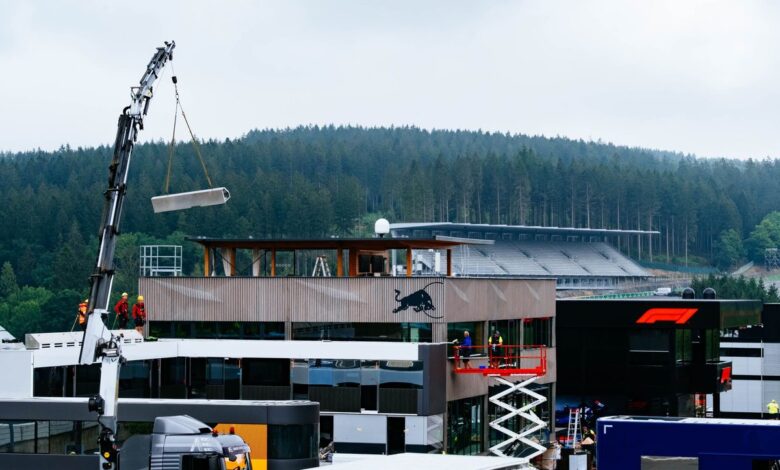How teams are solving the logistical puzzle of F1’s triple-headers

Once an anomaly during the pandemic, triple-headers have now become a standard fixture of the F1 calendar.
The first of three runs with three consecutive race weekends starts at this weekend’s Spanish Grand Prix in Barcelona, followed by an overland trip to Austria and then on to Silverstone.
Towards the end of the year there is a triple-header including Austin, Mexico and Brazil ahead of an even tougher end-of-season run of Las Vegas, Qatar and Abu Dhabi.
And while the two flyaway triplets across the Americas and the Middle East carry their own logistical and HR challenges, the summer run of Barcelona-Spielberg-Silverstone is the hardest to pull off.
Teams carry everything by trucks, and the maximum drive times for truck drivers and logistical limitations of certain venues are all part of a complex puzzle that teams have to resolve. The extra time that has to be factored in for customs between the UK and France in the post-Brexit world has added to the logistical headache of the 1600km trip.
“From Austria to Silverstone, the chassis will be stripped on Sunday night at the circuit, so they’re right back in the factory on Tuesday morning, ready for the factory staff to start,” Mercedes Head of Race Team Logistics Karl Fanson explained to Motorsport.com.
“Because of the customs process we go through now, we have to triple man the trucks to guarantee that we’re going to get back. Sometimes you clear customs within an hour, sometimes you’ll be waiting two or three hours. The paperwork and admin now is enormous. Before we used to double man the trucks but they can only do up to 21 hours and we can’t guarantee to get back to the factory in that time.”
It’s not just the upcoming triple-header that is causing headaches, but also the recent back-to-back of Imola and Monaco. Because of the cramped confines in the Monte Carlo harbour, with only one truck and crane able to enter the paddock area at a time, there is a strict build order so every team can build up its motorhome and workspaces in time. McLaren was delayed getting out of Imola, which then caused a snowball effect that also delayed Alpine’s motorhome build.
“Monaco was a bit of a challenge for a few teams this year,” said Mark Norris, McLaren’s Director of Race Operations. “We work with F1 and the FIA on timings and it only takes a little bit to go wrong and you have a knock-on effect. And we found that in Monaco this year, and purely from our perspective, we were a little bit delayed getting out of Imola. With Monaco being Monaco, once you’ve got one truck in, you’ve got to wait for that other truck so it’s a bit tetris-y.”

Red Bull and Mercedes truck in the paddock
Photo by: Mark Sutton / Motorsport Images
For teams like McLaren, the schedule involved in moving from race to race is extra tight because it’s one of the teams that just uses a single motorhome unit. Mercedes deploys a second smaller motorhome previously used in the DTM as a secondary unit, which has proven particularly useful for consecutive events.
“We have an advanced party and as we arrive at the circuit we do a handover and then they move on, Fanson said. “So on Thursday morning in Imola they left to Monaco, they came to work on Friday and started building the garage.”
Dennis Reck, Fanson’s counterpart in charge of motorhome logistics, added: “We’ve figured out quite early that the back-to-backs are a challenge, and you start looking into the risk of travel time and what the pros and cons are. It was a good decision to do Imola with the smaller unit and have the big one in Monaco. When the team arrived in Monaco on Monday, we had everything ready. People had a place to sit down and have lunch.”
Mercedes started using sustainable fuel for its fleet of trucks in 2022 and covered the entire European season the following year with trucks running on HVO100, or Hydrotreated Vegetable Oil 100. For 2024 it extended the use of sustainable fuels, together with McLaren, to cover all of its needs at the circuit.
Being early adopters has added extra costs and complexity in terms of sourcing the biodiesel, but it is a key element of their push towards a more sustainable operation, in line with F1’s net zero target for 2030. Investments in biofuel are exempt from the cost cap, which in Mercedes’ case also includes its investment in sustainable aviation fuel.
“We have a dedicated HVO truck to refuel all our trucks, so we keep them moving in the right direction,” Reck added. “Working with Petronas, we have partners who supply us with fuel on the go when we need it, so it’s quite useful rather than trying to hunt down gas stations that supply that. We’ve switched to Stage V generators using around 50% less fuel with AdBlue and HVO. We’re pushing really hard on that but it requires a lot of planning because that HVO is not easily found.”
McLaren has joined Mercedes in using HVO this year. “It’s something that we have really embraced,” said Norris. “It’s 75% greener, more efficient. Yes, the cost is slightly higher, but I think there’s a trade-off with the benefits that come into it.”
That also mirrors initiatives by F1 itself, which has doubled its HVO fleet to 37 trucks for this year and has sought to reduce the amount of freight needing to be shipped to races through its remote broadcast operations from the UK.
F1 also trialled a low-emission power system at last year’s Austrian Grand Prix based on HVO and solar energy, the data from which will be used to explore rolling the system out at more races.

McLaren F1 Team engineering hub
Photo by: Mark Sutton / Motorsport Images
In addition to the teams, race promoters are also heavily encouraged to make their events more sustainable, with 75% now using renewable energy to some degree.
McLaren has scaled down and revamped its old McLaren Brand Centre into a smaller unit, which now takes eight trucks to move it around instead of 18, while also halving the number of crew members needed to install and derig it. Meanwhile, Mercedes still uses the original structure with which the team re-entered the sport in 2010, albeit it has undergone several facelifts along the way.
Norris admitted that McLaren’s previous, mammoth unit would have made European triple-headers inconceivable. “I don’t know how you could do that now,” he nodded. “When we had the Brand Centre we had a few double-headers, but for triple-headers we would have had to up the manpower and have people driving through the night.
“We still have to do that now on some of the double-headers, but we either try and fly people ahead or we use sleeper coaches so they arrive roughly the same time while they’ve had their rest.”
The 2025 calendar will add an extra challenge as Imola and Monaco are forming a triple-header with Barcelona for what will be one of the most difficult logistical puzzles yet that squads are already thinking about now. While the drive from Monaco to Barcelona is relatively short, being able to derig and get all the equipment out of the principality in time will be tricky for all involved.
“We do have two hospitality units available, so it’s for us to discuss where our priority focus is,” said Reck.
“The big challenge is to get the trucks out, because during the takedown on Sunday night there are hundreds of guests running around. It is tricky, but on the other hand we’re grateful for how the sport is being experienced in the city.”

Haas F1 team equipment arrives in the pitlane
Photo by: Andy Hone / Motorsport Images
For flyaways, F1 teams have more and more shifted from air freight to sea freight. Only the most crucial performance-defining parts and tools, including the cars themselves, are being jetted around the world on DHL’s Boeing 777 cargo planes, which are more efficient than the previous generation of 747 jumbos and reduce emissions by 17%.
Other equipment such as garage infrastructure is stored in hubs around the world, including Florida, Singapore and the Middle-East, and shipped or trucked from there to the races in the region. Most teams have six sets of everything, so while the European kit was used in Imola and Monaco, the North American set deployed in Miami was sent out to Montreal. The practice comes with an up-front cost, but pays off both in shipping expenses and CO2 emissions.
“We’re starting to look at a lot more of that. Why do we always need to bring this equipment or these sets back?,” said Norris.
“It also takes risk away and we’ve seen issues with the Red Sea, Suez Canal, ships are getting held. By looking at that differently we can be much more clever, and that also helps Formula 1 from a sustainability perspective.
“I don’t think for the foreseeable future it will change, but if you want to be more sustainable, do we still move 180 trucks around Europe just for those nine races or are those flyaway kits something that we should be looking at for Europe as well?”

F1 truck
Photo by: Sam Bloxham / Motorsport Images







